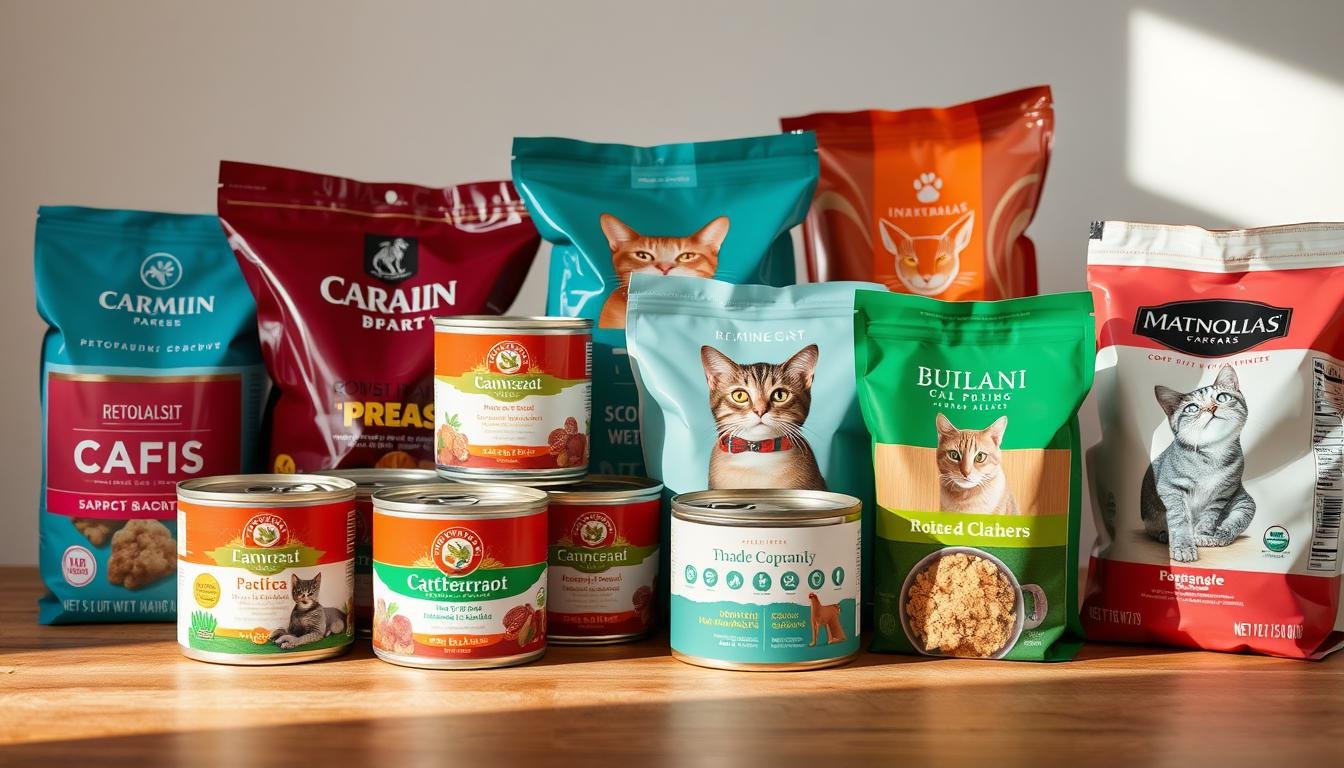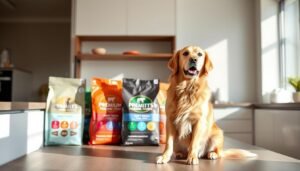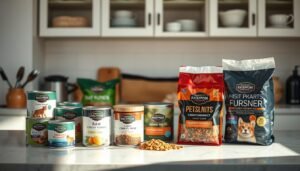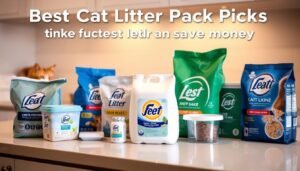When I first got my cat, I found out not all cat food is the same. My cat didn’t like many foods that were supposed to be the best. But then, I tried premium cat food and she loved it.
Choosing healthy cat food is more than just good nutrition. It’s about finding food she really likes. This search taught me how important it is to pick brands that are both nutritious and tasty for my cat. The right food makes her happy and healthy.
Key Takeaways
- Not all cat foods are created equal; palatability matters.
- Healthy cat food can significantly impact your cat’s health and happiness.
- Premium cat food brands often offer a better balance of ingredients.
- Understanding your cat’s taste preferences is key.
- Finding a nutritious option that your cat enjoys can be a journey.
Why Choosing the Right Cat Food Matters
The health of our cats depends a lot on their food. Choosing the right food can really help them. Knowing what your cat needs is the first step.
Cats need a lot of protein because they are meat eaters. So, we must pick their food carefully.
Understanding Your Cat’s Nutritional Needs
When picking cat food, look at the six key nutrients from the AAFCO. These are:
- Proteins: Important for growth and health.
- Fats: Good for energy and skin.
- Carbohydrates: Give energy and help the gut.
- Vitamins: Help with many body functions.
- Minerals: Key for strong bones and health.
- Water: Keeps your cat hydrated and healthy.
The Impact of Quality Ingredients on Health
Good ingredients are key for your cat’s health. Food with quality ingredients can boost their immune system and coat. It also gives them more energy.
When I see clear ingredients on the label, I feel good about what I’m feeding my cat. Foods with specific meats and healthy extras are best.
Reading Labels: What to Look For
It’s important to know how to read cat food labels. Here’s what I look for:
| Label Element | What It Indicates |
|---|---|
| Protein Source | Look for named meats, such as chicken or fish, instead of generic terms like “meat meal.” |
| Ingredients Order | The first few ingredients should be high-quality protein sources, not fillers like corn or wheat. |
| Additives and Nutrients | Check for added vitamins, minerals, and essential fatty acids that support your cat’s health. |
| AAFCO Statement | This indicates the food meets the nutritional standards set by the industry. |
Top Healthy Cat Food Brands
Finding the right food for my cat is hard with so many choices. I’ve found three top brands that are vet-approved. They meet my cat’s nutritional needs well.
Brand 1: Wellness
Wellness has many wet and dry foods rich in protein and nutrients. They use quality ingredients without fillers. Pet owners like the clear ingredient list and no artificial stuff.
This makes Wellness a great choice. It boosts my cat’s health with antioxidants.
Brand 2: Blue Buffalo
Blue Buffalo uses wholesome ingredients. Their LifeSource Bits add antioxidants, vitamins, and minerals. They focus on real meat for protein.
Knowing it’s a premium brand makes me feel good. It fits many dietary needs, including grain-free. For more info, check this resource.
Brand 3: Royal Canin
Royal Canin makes diets for specific breeds, ages, and health needs. Their science-based approach is vet-approved. Each bag has key nutrients for all eaters.
Switching to Royal Canin improved my cat’s coat and digestion. It’s known for being top-notch.
Grain-Free Options for Cats
Choosing the right food for my cat is very important. I’ve been looking into grain-free cat food. It’s good for cats with food sensitivities.
There are many great grain-free brands out there. This makes it easy to find the right food for my cat.
Benefits of Grain-Free Diets
Grain-free diets have many benefits for cats. Cats need a lot of protein to stay healthy. Here are some good points:
- Improved digestion and fewer stomach problems.
- Less carbs help with weight control.
- It’s good for cats with sensitive stomachs.
Top Grain-Free Cat Food Brands
Many brands are known for their grain-free cat food. Here are some top brands I found:
| Brand Name | Key Features | Flavor Options |
|---|---|---|
| Wellness CORE | High protein, grain-free, with real meat | Turkey, Chicken, Salmon |
| Blue Buffalo Wilderness | Natural ingredients, grain-free options | Chicken, Salmon, Duck |
| Canidae PURE | Limited ingredients, grain-free | Duck, Venison, Lamb |
Transitioning Your Cat to a Grain-Free Diet
Switching to grain-free food can be easy. Just do it slowly. Here’s how:
- Mix a little grain-free food with her old food.
- Slowly add more grain-free food each day.
- Watch how she does and make changes if needed.
Wet vs. Dry Cat Food: What’s Best?
Choosing between wet and dry cat food can be hard. Each has its own good and bad points. It’s key to find the right mix for your cat’s health and happiness.
Pros and Cons of Wet Cat Food
Wet cat food has more water, which is great for staying hydrated. Cats eating only dry food might not drink enough water. This can cause urinary problems.
But, wet food is less easy to store and lasts less time once opened. It also costs more than dry food.
Benefits of Dry Cat Food
Dry cat food is great for busy owners. It’s simple to store and serve. The crunchy texture also helps keep teeth clean by reducing plaque.
Yet, dry food has less water, which can cause dehydration if your cat doesn’t drink enough.
Finding the Right Balance
For the best diet, mix wet and dry food. This way, your cat gets the water from wet food and the ease of dry food. Watch how your cat acts and feels, and change their diet as needed.
Organic Cat Food Brands Worth Trying
I often choose organic cat food. It has fewer pesticides and additives. This makes our cats healthier and happier.
Benefits of Organic Ingredients
Organic cat food is good for my pets. It has no synthetic preservatives. This helps their immune systems.
Organic food is also fresher. It has more nutrients. I know my cat eats food without harmful chemicals.
Popular Organic Cat Food Brands
Many brands offer quality organic cat food. This makes it easy to find healthy options. Some of my favorites are:
- Nature’s Logic: Uses whole foods without synthetic additives.
- Newman’s Own: Offers organic food that helps charities.
- Canidae: Has grain-free organic food for better digestion.
These brands focus on quality organic ingredients. They ensure our pets get the best nutrition.
How to Introduce Organic Foods to My Cat
Changing to organic food takes time. I mix it with their old food for a week. This helps them get used to the new taste and texture.
If they’re not sure, I warm the food a bit. Or I add their favorite treats. This makes mealtime more fun.
Special Dietary Needs: What to Consider
When we care for our cats, knowing their special diet needs is key. Cats can have food allergies and sensitivities. This can lead to health problems. Choosing the right special cat food helps keep them healthy.
Understanding Food Sensitivities
Food sensitivities can cause many issues, like upset stomachs or skin problems. To find out what’s causing these problems, watch how your cat acts and feels after eating. Signs include throwing up, having diarrhea, or scratching a lot.
Keeping a food diary can help find out what foods are bad. This makes picking the right cat food easier.
Best Cat Foods for Allergies
For cats with allergies, finding hypoallergenic foods is important. Brands like Hill’s Science Diet and Purina Pro Plan make special formulas. These foods have new proteins and fewer ingredients to lower allergy risks.
I like Royal Canin’s hypoallergenic food for sensitive cats. It works well.
Cats with Special Nutritional Needs
Cats with health issues like diabetes or kidney disease need special diets. Talking to a vet is very helpful. They can suggest the best food for your cat’s needs.
Special cat food should give them the right nutrients. Regular vet visits help keep their diet on track.
Homemade Cat Food: Is It Worth It?
Thinking about homemade cat food opens up many options and things to think about. Many pet owners like making their cat’s food at home. But, it’s important to know the good and bad before starting.
Pros and Cons of DIY Cat Food
Homemade cat food has its perks. You get to choose what goes into it and make meals just right for your cat. It’s great to know exactly what your pet eats.
But, making food at home takes time and effort. There’s also a chance of not getting all the nutrients right. Cats need special nutrients, and it can be hard to make sure they get them.
Basic Recipes for Healthy Cat Meals
Making healthy cat food can be easy. Here are two simple recipes I like:
- Chicken and Rice: Mix cooked, shredded chicken with plain brown rice. Add a bit of carrot for extra fiber.
- Fish Delight: Mix canned tuna in water with pumpkin and a bit of cooked spinach. It’s tasty and good for your cat.
Ensuring Nutritional Balance in Homemade Diets
To keep my cat’s diet balanced, I follow the AAFCO guidelines. I use different proteins, vitamins, and minerals. Sometimes, I add supplements to fill any gaps.
It’s key to make sure every ingredient is safe for cats. This keeps them healthy and happy.
Tips for Transitioning Cat Foods
Changing cat foods needs care. Knowing when your cat needs a new diet is key. Look for signs like less interest in food, digestive issues, or allergies. These can mean it’s time for a diet change.
Signs Your Cat May Need a New Diet
- Increased Vomiting: Frequent vomiting can indicate food intolerance.
- Changes in Appetite: A sudden decrease in interest in meals can signify a need for dietary adjustments.
- Weight Fluctuations: Unexplained weight loss or gain may require a review of food options.
- Digestive Upset: Diarrhea or constipation can suggest the food may not be suitable.
Step-by-Step Guide to Transitioning
To smoothly switch to a new cat food, I use a structured plan. These steps help reduce stress and support my cat:
- Days 1-2: Mix 75% of the old food with 25% of the new food.
- Days 3-4: Adjust to a 50/50 ratio of old to new food.
- Days 5-6: Shift to 25% old food and 75% new food.
- Day 7: Serve only the new food.
This gradual introduction makes it easier for my cat to adjust. If problems come up, I look at guidelines on transitioning cat foods for help.
Monitoring Your Cat’s Response
During the transition, I watch my cat’s health closely. It’s important to note any reactions. If my cat shows signs of intolerance, like vomiting or diarrhea, I slow down the change.
I make sure my cat eats enough food to avoid health problems. If they don’t want the new food, I offer a little of the old food. This helps them get used to the new food.
My Cat Food Preferences: Trial and Error
Learning what my cats like to eat takes patience and trying different things. Each cat is different, so it’s a journey to find what they like. Watching how they react to different foods helps me pick the best ones for them.
Discovering What Your Cat Loves
I’ve tried many foods to see what my cats prefer. Some like chicken, fish, or turkey more than others. Watching how fast they eat and if they leave food shows me what they like.
This helps me choose foods that are good for them and taste great.
Adjusting Diet Based on Taste and Texture
Texture is as important as taste for my cats. If they don’t like the feel of food, they won’t eat it. So, I’ve tried different types of food, like wet and dry.
Finding the right mix makes mealtime fun. They like trying new things, and it keeps them happy.
How to Keep Mealtime Fun and Engaging
I use puzzle feeders and toys to make meals fun. These toys make them think and work for their food. It turns eating into a game they love.
With these ideas, my cats enjoy their meals. It makes mealtime a special time for all of us.





















